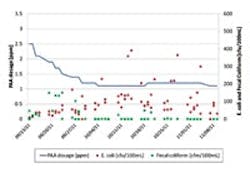About the author: Minh Tran is commercial development manager for FMC Environmental Solutions. Tran can be reached at [email protected] or 866.860.4760.
Chlorine has been the principal disinfectant used in the wastewater industry. The chlorine disinfection process, however, produces inorganic chloramines and chlorinated disinfection byproducts (DBPs), such as trihalomethanes, which are toxic to aquatic life.
Despite some recent advances in the measurement and control of chlorination/dechlorination technology, challenges remained for wastewater treatment plants (WWTPs) attempting to meet the required standards for pathogen treatment while maintaining a chlorine residual level of less than 0.01 ppm.
The Hannibal WWTP in Missouri has an average flow of 3.5 million gal per day. The plant sought an alternative disinfection process that did not require dechlorination and was cost effective and simple to operate.
After preliminary review, VigorOx WWT II was selected as the most attractive alternative disinfection option, because the plant’s existing contact chamber could be retrofitted, providing a large savings in capital costs versus dechlorination or ultraviolet disinfection.
VigorOx WWT II, a proprietary peracetic acid (PAA)-based formulation from FMC Corp., is an equilibrium mixture of peracetic acid, acetic acid, hydrogen peroxide and water. The formulation reacts to form chlorine-free DBPs, acetic acid (vinegar) and water in the effluent. All of these are environmentally benign in the wastewater effluent.
The product has several other attributes that make it desirable as a wastewater disinfectant, including its ease of operation, small footprint, low capital costs, efficacy across a broad pH range and rapid disinfection rate.
A full-scale disinfection system was set up at the Hannibal WWTP with the following criteria to be evaluated:
• Pathogen performances: E. coli and fecal coliform;
• Effluent quality performances: biochemical oxygen demand (BOD) and total suspended solid (TSS); and
• Aquatic toxicity results: whole effluent toxicity.
The disinfection system consists of a chemical feed system, a PAA residual monitor and a control network. During the full-scale trial period, VigorOx WWT II was dosed into the contact tank using peristaltic pumps that were calibrated prior to the trial. The chemical feed system was connected to the plant’s flow-pacing signal, enabling a reliable dosing control based on real-time flow rate.
Pathogen Performances
The trial ran for 57 days. The main objective of the trial was to investigate PAA’s ability to meet an upcoming E. coli requirement of 126 cfu/100 mL. As anticipated, a dosage as low as 1.4 ppm PAA was found to be effective at meeting this goal. As the trial progressed, the dosage was further reduced to as low as 1.1 ppm PAA. Even at this low dosage, the average E. coli counts were still below the discharge requirements (see Figure 1).
A similar performance was demonstrated in the reduction of fecal coliform, with the formulation capable of maintaining fecal coliform counts well below the discharge limit.
Effluent Quality Performances
The plant’s discharge limit for BOD is 40 mg/L on a weekly average and 30 mg/L on a monthly average (geometric means). Testing showed that VigorOx WWT II met the discharge BOD requirement. Similarly, the TSS discharge limit for the plant is 40 mg/L on a weekly average and 30 mg/L on a monthly average. The geometric average from TSS concentration during the trial period was less than 11 mg/L. The maximum TSS reading was
26 mg/L. A change in the disinfectant’s dosage does not have a responsive effect on the effluent BOD and TSS concentrations.
Aquatic Toxicity Results
The first whole effluent toxicity test was carried out on Nov. 9, 2011, at the Environmental Analysis South Laboratory. The testing was completed at different effluent dilutions ranging from 0 (the control) to 40%. The result of the first whole effluent test indicated a pass for both the Pimephales promelas (fathead minnow) and Ceriodaphnia dubia (a species of water flea), showing a 100% survival rate at the allowable effluent concentration of 10%.
The second whole effluent test indicated a survival rate for P. promelas at 95% at the allowable effluent concentration. The data also showed a higher survival rate (100%) for C. dubia at the same effluent concentration.
User Recommendations
At the lowest dosage tested (1.1 ppm PAA), E. coli met the discharge requirement. A dosage of 1.4 ppm PAA or higher yielded exceptionally low counts of E. coli, leading to a recommendation that for a full-scale permanent VigorOx WWT II installation, a dosage of 1.4 ppm PAA should be used as an optimum dosage.
The disinfection system was tested thoroughly over an extended time and matched specifically to the needs of the Hannibal WWTP. This substitute for chlorination processes proved to be fully capable of meeting requirements for both pathogen performances and effluent quality performances and was safe for local aquatic species.
Download: Here
